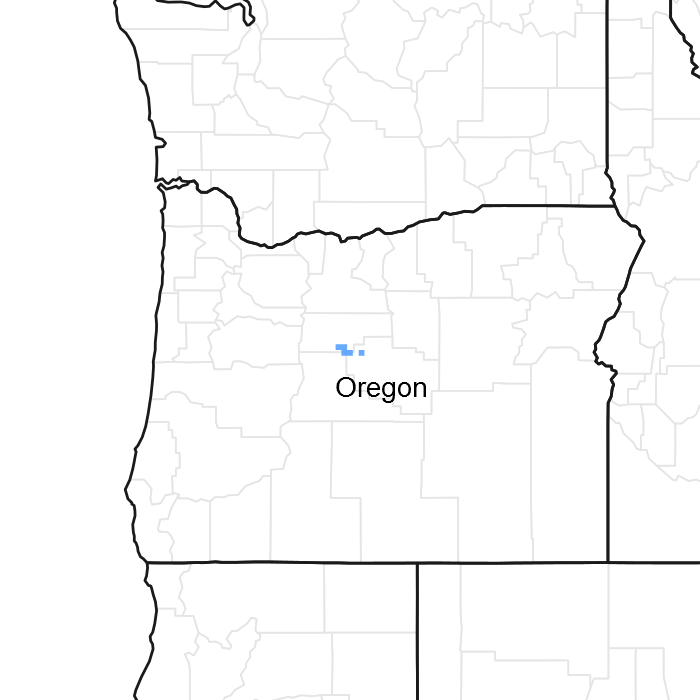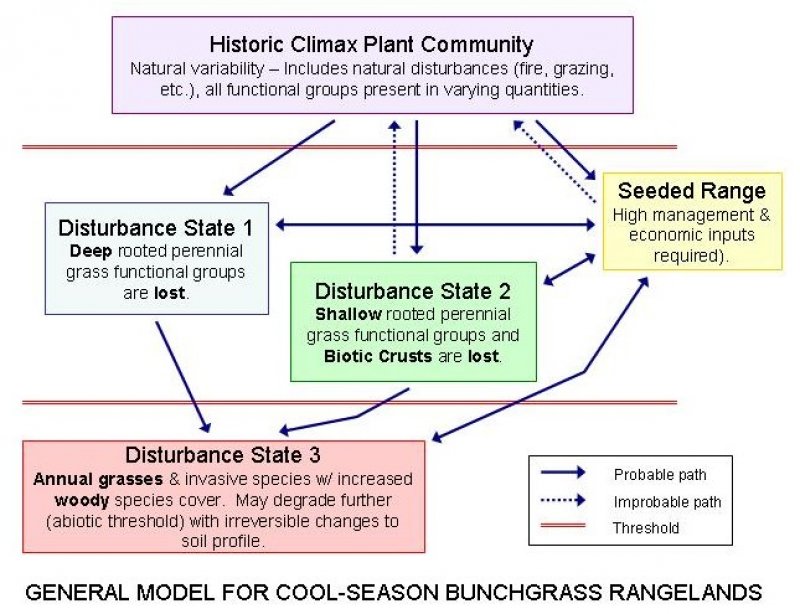
Natural Resources
Conservation Service
Ecological site R010XB024OR
JD Warm Ashy Claypan 9-12 PZ
Accessed: 04/02/2025
General information
Provisional. A provisional ecological site description has undergone quality control and quality assurance review. It contains a working state and transition model and enough information to identify the ecological site.

Figure 1. Mapped extent
Areas shown in blue indicate the maximum mapped extent of this ecological site. Other ecological sites likely occur within the highlighted areas. It is also possible for this ecological site to occur outside of highlighted areas if detailed soil survey has not been completed or recently updated.
Associated sites
| R010XB034OR |
JD Loamy 9-12 PZ Loamy 10-12 PZ |
|---|---|
| R010XB064OR |
JD North 9-12 PZ Droughty North 9-12" PZ |
Similar sites
| R023XY216OR |
CLAYPAN 12-16 PZ Clayey 10-16 PZ |
|---|---|
| R023XY511OR |
JUNIPER LAVA BENCHES 9-12 PZ Juniper Lava Benches |
Table 1. Dominant plant species
| Tree |
Not specified |
|---|---|
| Shrub |
Not specified |
| Herbaceous |
Not specified |
Physiographic features
This site occurs on hills, ridge slopes, upland terraces, and small basins. Slopes typically range from 0-20 percent but some short slopes may reach 35 percent or more. Elevations range from 3,000 to 4,500 feet.
Table 2. Representative physiographic features
| Landforms |
(1)
Hill
(2) Terrace (3) Ridge |
|---|---|
| Elevation | 914 – 1,372 m |
| Slope | 0 – 20% |
| Water table depth | 152 cm |
| Aspect | Aspect is not a significant factor |
Climatic features
The annual precipitation typically ranges from 10 to 12 inches, but reaches 15 in places. It occurs mainly between the months of October and June, mostly in the form of rain and snow. The soil temperature regime is mesic. The average annual air temperature is 48 degrees F with extreme temperatures ranging from -20 to 108 degrees F. The frost free period is 90 to 120 days. The optimum period for plant growth is late March through June.
Table 3. Representative climatic features
| Frost-free period (average) | 120 days |
|---|---|
| Freeze-free period (average) | 0 days |
| Precipitation total (average) | 305 mm |
Figure 2. Monthly average minimum and maximum temperature
Influencing water features
Soil features
The soils of this site are very deep, well-drained, and have a medium textured surface. They are generally formed from loess over colluvium. Permeability is slow and the available water holding capacity (AWC) is 5.0 to 10.0 inches for the profile.
Table 4. Representative soil features
| Drainage class | Well drained |
|---|---|
| Permeability class | Slow |
| Available water capacity (0-101.6cm) |
12.7 – 25.4 cm |
Ecological dynamics
Range in Characteristics:
South aspects will have more bluebunch wheatgrass and less Idaho fescue than typical. North slopes will produce a higher percentage of Idaho fescue and less bluebunch wheatgrass.
Response to Disturbance and Invader Species:
Burning decreases juniper, low sagebrush, bitterbrush, and Idaho fescue. Overgrazing results in a decrease in Idaho fescue and an increase in Sandberg Bluegrass. Further deterioration will result in an increase of squirreltail, California brome, cheatgrass, pepperweed, collinsia, low larkspur, and deathcamas.
State and transition model

More interactive model formats are also available.
View Interactive Models
More interactive model formats are also available.
View Interactive Models
Click on state and transition labels to scroll to the respective text
Ecosystem states
State 1 submodel, plant communities
State 1
Historic Climax Plant Community
Community 1.1
Historic Climax Plant Community
The potential native plant community is dominated by western juniper, low sagebrush, and Idaho fescue. Bluebunch wheatgrass and Sandberg bluegrass are common along with a variety of forbs such as fleabane, lupine, pussytoes, yarrow, aster, and spreading phlox. Bitterbrush is usually present. Vegetative composition is approximately 75 percent grasses, 5 percent forbs, and 20 percent shrubs/trees. Total foliar cover is about 70 percent, of which 10 percent is tree cover, 10 percent is shrub cover, and 50 percent is grass/forb cover.
Figure 3. Annual production by plant type (representative values) or group (midpoint values)
Table 5. Annual production by plant type
| Plant type | Low (kg/hectare) |
Representative value (kg/hectare) |
High (kg/hectare) |
|---|---|---|---|
| Grass/Grasslike | 316 | 493 | 666 |
| Shrub/Vine | 81 | 123 | 168 |
| Forb | 27 | 47 | 67 |
| Tree | 20 | 28 | 34 |
| Total | 444 | 691 | 935 |
Additional community tables
Table 6. Community 1.1 plant community composition
| Group | Common name | Symbol | Scientific name | Annual production (kg/hectare) | Foliar cover (%) | |
|---|---|---|---|---|---|---|
|
Grass/Grasslike
|
||||||
| 1 | Perennial, deep-rooted, dominant | 269–538 | ||||
| Idaho fescue | FEID | Festuca idahoensis | 202–336 | – | ||
| bluebunch wheatgrass | PSSP6 | Pseudoroegneria spicata | 67–202 | – | ||
| 2 | Perennial, deep-rooted, sub-dominant | 7–13 | ||||
| sedge | CAREX | Carex | 7–13 | – | ||
| 4 | Perennial, shallow-rooted, sub-dominant | 40–114 | ||||
| Sandberg bluegrass | POSE | Poa secunda | 34–101 | – | ||
| prairie Junegrass | KOMA | Koeleria macrantha | 7–13 | – | ||
|
Forb
|
||||||
| 7 | Perennial, all, dominant | 20–40 | ||||
| fleabane | ERIGE2 | Erigeron | 7–13 | – | ||
| lupine | LUPIN | Lupinus | 7–13 | – | ||
| spreading phlox | PHDI3 | Phlox diffusa | 7–13 | – | ||
| 9 | Other annual forbs, all | 7–27 | ||||
| common yarrow | ACMI2 | Achillea millefolium | 0–6 | – | ||
| pussytoes | ANTEN | Antennaria | 0–6 | – | ||
| buckwheat | ERIOG | Eriogonum | 0–6 | – | ||
| aster | EUCEP2 | Eucephalus | 0–6 | – | ||
| desertparsley | LOMAT | Lomatium | 0–6 | – | ||
|
Shrub/Vine
|
||||||
| 11 | Perennial, evergreen, dominant | 67–101 | ||||
| little sagebrush | ARAR8 | Artemisia arbuscula | 67–101 | – | ||
| 12 | Perennial, evergreen, sub-dominant | 13–67 | ||||
| mountain big sagebrush | ARTRV | Artemisia tridentata ssp. vaseyana | 7–34 | – | ||
| antelope bitterbrush | PUTR2 | Purshia tridentata | 7–34 | – | ||
|
Tree
|
||||||
| 16 | Perennial, evergreen, dominant | 20–34 | ||||
| western juniper | JUOC | Juniperus occidentalis | 20–34 | – | ||
Interpretations
Animal community
Livestock Grazing:
The key forage species is Idaho fescue. Use should be postponed until the soils are firm enough to avoid trampling damage and soil compaction.
Native Wildlife Associated with the Climax Community:
Mule deer
Coyotes
Rabbits
Rodents
This site offers food and cover for mule deer, rodents, and a variety of birds. It is an important wintering area for mule deer.
Hydrological functions
The soils of this site have low infiltration rates and high runoff potential.
Wood products
This site is susceptible to an increase in western juniper. Where this has occured, the site will produce firewood, posts, and specialty products.
Other information
For range seedings, recommended species include crested wheatgrass, pubescent wheatgrass, secar bluebunch wheatgrass, tall wheatgrass, and sheep fescue. Increase in western juniper and the subsequent competition for moisture will lead to a reduction of availabe forage. Overgrazing can easily reduce ground cover and accelerate soil loss. Improving infiltration and permeability, and reducing runoff should be the immediate goal of juniper and brush control.
Supporting information
Contributors
JPR
M. Parks (OSU)
S.F. Greenfield, G. Hickman
Rangeland health reference sheet
Interpreting Indicators of Rangeland Health is a qualitative assessment protocol used to determine ecosystem condition based on benchmark characteristics described in the Reference Sheet. A suite of 17 (or more) indicators are typically considered in an assessment. The ecological site(s) representative of an assessment location must be known prior to applying the protocol and must be verified based on soils and climate. Current plant community cannot be used to identify the ecological site.
| Author(s)/participant(s) | Jeff Repp and Bruce Frannsen |
|---|---|
| Contact for lead author | State Rangeland Management Specialist for NRCS - Oregon |
| Date | 08/06/2012 |
| Approved by | Bob Gillaspy |
| Approval date | |
| Composition (Indicators 10 and 12) based on | Annual Production |
Indicators
-
Number and extent of rills:
None, slight to moderate sheet & rill erosion hazard -
Presence of water flow patterns:
None -
Number and height of erosional pedestals or terracettes:
None -
Bare ground from Ecological Site Description or other studies (rock, litter, lichen, moss, plant canopy are not bare ground):
5-15% -
Number of gullies and erosion associated with gullies:
None -
Extent of wind scoured, blowouts and/or depositional areas:
None, slight wind erosion hazard -
Amount of litter movement (describe size and distance expected to travel):
Fine - limited movement -
Soil surface (top few mm) resistance to erosion (stability values are averages - most sites will show a range of values):
Moderately resistant to erosion: aggregate stability = 3-5 -
Soil surface structure and SOM content (include type of structure and A-horizon color and thickness):
Very deep, well drained silt loams: moderate OM (2-4%) -
Effect of community phase composition (relative proportion of different functional groups) and spatial distribution on infiltration and runoff:
Moderate ground cover (60-70%) and gentle slopes (0-20%) moderately limit rainfall impact and overland flow -
Presence and thickness of compaction layer (usually none; describe soil profile features which may be mistaken for compaction on this site):
None -
Functional/Structural Groups (list in order of descending dominance by above-ground annual-production or live foliar cover using symbols: >>, >, = to indicate much greater than, greater than, and equal to):
Dominant:
Idaho fescue > Bluebunch wheatgrass > Low sagebrush > other grasses > other shrubs > forbsSub-dominant:
Other:
Additional:
-
Amount of plant mortality and decadence (include which functional groups are expected to show mortality or decadence):
Normal decadence and mortality expected -
Average percent litter cover (%) and depth ( in):
-
Expected annual annual-production (this is TOTAL above-ground annual-production, not just forage annual-production):
Favorable: 800, Normal: 600, Unfavorable: 400 lbs/acre/year at high RSI (HCPC) -
Potential invasive (including noxious) species (native and non-native). List species which BOTH characterize degraded states and have the potential to become a dominant or co-dominant species on the ecological site if their future establishment and growth is not actively controlled by management interventions. Species that become dominant for only one to several years (e.g., short-term response to drought or wildfire) are not invasive plants. Note that unlike other indicators, we are describing what is NOT expected in the reference state for the ecological site:
Western Juniper readily invades the site. Cheatgrass and Medusahead invade sites that have lost deep rooted perennial grass functional groups. -
Perennial plant reproductive capability:
All species should be capable of reproducing annually
Print Options
Sections
Font
Other
The Ecosystem Dynamics Interpretive Tool is an information system framework developed by the USDA-ARS Jornada Experimental Range, USDA Natural Resources Conservation Service, and New Mexico State University.
Click on box and path labels to scroll to the respective text.